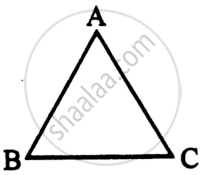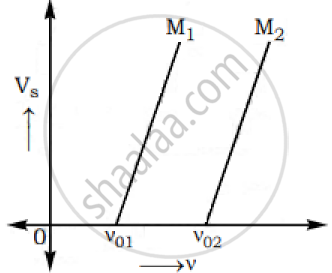Advertisements
Advertisements
Question
Find the wave number of a photon having energy of 2.072 eV
Given : Charge on electron = 1.6 x 10-19 C,
Velocity of light in air = 3 x 108 m/s,
Planck’s constant = 6.63 x 10-34 J-s.
Solution
E = hv
`:.v=E/h`
`v=C/lambda`
∴ Wave number
`1/lambda=v/c`
`=E/(hc)`
`=(2.072xx1.6xx10^(-19))/(6.63xx10^(-34)xx3xx10^8`
`=1/lambda=1.667xx10^6m^(-1)`
APPEARS IN
RELATED QUESTIONS
The energy of photon of wavelength X is_____ .
[h = Planck’s constant, c = speed of light in vacuum]
The threshold wavelength of silver is 3800Å. Calculate the maximum kinetic energy in eV of photoelectrons emitted, when ultraviolet light of wavelength 2600Å falls on it.
(Planck’s constant, h =6.63 x 1O-34J.s.,
Velocity of light in air, c = 3 x 108 m / s)
The photoelectric threshold wavelength of a metal is 230 nm. Determine the maximum kinetic energy in joule and in eV of the ejects electron for the metal surface when it is exposed to a radiation of wavelength 180 nm.
[Planck’s constant : h = 6.63 * 10-34 Js, Velocity of light : C = 3 * 108 m/s.]
Find the value of energy of electron in eV in the third Bohr orbit of hydrogen atom.
(Rydberg's constant (R) = 1· 097 x 107m - 1,Planck's constant (h) =6·63x10-34 J-s,Velocity of light in air (c) = 3 x 108m/ s.)
State two important properties of photon which are used to write Einstein’s photoelectric equation.
Radiation of frequency 1015 Hz is incident on two photosensitive surface P and Q. There is no photoemission from surface P. Photoemission occurs from surface Q but photoelectrons have zero kinetic energy. Explain these observations and find the value of work function for surface Q.
The work function for a metal surface is 2.2eV. If the light of wavelength 5000Å is incident on the surface of the metal, find the threshold frequency and incident frequency. Will there be an emission of photoelectrons or not? (c = 3 x 108 m/ s, 1eV = 1.6x10-19 J , h = 6.63 x 10-34 J.s.)
Einstein's photoelectric equation is:
a) `E_"max" = hlambda - varphi_0`
b) `E_"max"= (hc)/lambda varphi_0`
c) `E_"max" = hv + varphi_0`
d) `E_"max" = (hv)/lambda + varphi_0`
Write the basic features of photon picture of electromagnetic radiation on which Einstein’s photoelectric equation is based.
Write Einstein’s photoelectric equation.
According to Einstein’s model, the threshold frequency for a metal having work function ϕ0 is given by _________.
Plot a labelled graph of |Vs| where Vs is stopping potential versus frequency f of the incident radiation. State how will you use this graph to determine the value of Planck's constant?
A police van moving on a highway with a speed of 30 km/h fires a bullet at a thief's car speeding away in the same direction with a speed of 192 km/h. If the muzzle speed of the bullet is 150 m is, with what speed does the bullet hit the thief's car?
In an inelastic collision, which of the following does not remain conserved?
Radiations of two photon's energy, twice and ten times the work function of metal are incident on the metal surface successively. The ratio of maximum velocities of photoelectrons emitted in two cases is:
According to Einstein's photoelectric equation, the plot of the kinetic energy of the emitted photoelectrons from a metal Vs the frequency of the incident radiation gives as straight the whose slope:
Dimensions of ‘resistance’ are same as (where h is Planck's constant and e is charge):
Threshold frequency for photoelectric effect on sodium corresponds to a wave length 5000. Its work function is ______.
Einstein work on the photoelectric effect provided support for the eqn:-
If the energy of photon corresponding to a wavelength of 6000 A° is 3.32 × 10-19 J, the photon energy for a wavelength of 4000 A° will be
What will be wavelength of a photon of momentum 6.6 × 10–24 kgms–1?
What is the momentum of photon of energy 3 mev in kg ms-1?
(i) A ray of light incident on face AB of an equilateral glass prism, shows minimum deviation of 30°. Calculate the speed of light through the prism.

(ii) Find the angle of incidence at face AB so that the emergent ray grazes along the face AC.
- Calculate the energy and momentum of a photon in a monochromatic beam of wavelength 331.5 nm.
- How fast should a hydrogen atom travel in order to have the same momentum as that of the photon in part (a)?
Ultraviolet light is incident on metals P, Q and R, having work functions 8 eV, 2 eV and 4 eV respectively,
- Which metal has lowest threshold frequency for photoelectric effect?
- For which metal is the value of Emax minimum?
(Note: Emax is maximum kinetic energy of the emitted photoelectrons.)
The graphs below show the variation of the stopping potential VS with the frequency (ν) of the incident radiations for two different photosensitive materials M1 and M2.

Express work function for M1 and M2 in terms of Planck’s constant(h) and Threshold frequency and charge of the electron (e).
If the values of stopping potential for M1 and M2 are V1 and V2 respectively then show that the slope of the lines equals to `(V_1-V_2)/(V_(01)-V_(02))` for a frequency,
ν > ν02 and also ν > ν01
